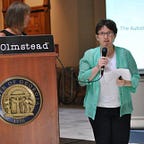the facts I have, and what I still don’t know: notes on autistic trans selfhood
I am 1 hour late to Transgender Day of Remembrance, if we are going by Eastern Time.
I wanted to write something political. I wanted to write something that would move people. I wanted to write something that said all the right things. I wanted to write something that would bring hope, even if just a little, in a time when we need it the most. I wanted to write something about the times we’re in when trans people are considering — or are — de-transitioning. I wanted to write about how we should not be passing around suicide hotlines after an election and how Trans Lifeline is overloaded with calls.
I wanted to write about the people I have never met and maybe never will, because they are dead (in which case definitely never will), or because I don’t know how to un-silo my identities sometimes, or convince people to take my disabled identity along with me because you cannot separate me from my disability and I cannot stop being disabled just because I enter your spaces and everything is overwhelmingly bright and loud but I cannot figure how to ask everyone to tone it down some because I am afraid of accidentally trying to silence you.
(I only went to my first pride in 2015 because I was terrified of the noise, and wore my noise-cancelling headphones with music playing and carried a sign that said “Autistic and LGBTQ+ Pride” and flapped a lot to self-regulate and tried to avoid the crowds and tried to stick with the person I was with and still had to leave before too long).
I wanted to write about how much it hurts to know that all your communities have a suicide problem and all your communities have members get murdered and you feel like you have to mourn both separately even though the following facts are true:
The autistic community has a higher than average chance of being trans, non-binary, or gender non-conforming and autistic adults without intellectual disabilities are nine times more likely to die by suicide than their non-autistic peers. There is a dedicated site to those we have lost to filicide. The trans community reports a 41% suicide attempt rate, as opposed to 4.6% of the general population, and 2016 breaks the record for most trans people murdered in a year.
What happens when you’re trans and autistic?
I mourn the deaths.
I do not know the answers to how I will act to be not just an autistic activist with mental health disabilities, but also a trans activist who fights more deaths in the trans community. I want to be an activist who is aware of the intersections that trans people have — trans people of color, autistic trans people, otherwise disabled trans people, and so many other intersections — and tries to work in the space I have and not overtake others’ voices.
But I am still working out my non-binary and trans identity. I am still trying to figure out how to create spaces that work for both autistic trans people like me and non-autistic trans people. I am still working on figuring out how to be a part of more than one community.
I wanted to write about something political. I wanted to write something that would move people. I wanted to write something that said all the right things. I wanted to write something that would bring hope, even just a little, in a time we need it the most.
I wrote what I could instead.
Originally published at kpagination.wordpress.com on November 21, 2016.
